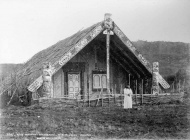Personal details
Full Name:
- Tūkāroto Pōtatau Matutaera Tāwhiao
Lifetime:
- ?–26 Aug 1894
 Tūkāroto Pōtatau Matutaera Tāwhiao
Tūkāroto Pōtatau Matutaera Tāwhiao
Tāwhiao's father Pōtatau was the first Māori King, and on his death in 1860 Tāwhiao inherited the kingship and the spiritual leadership of his people. He was king for the next 34 years, including the most turbulent period in New Zealand's race relations history.
Read more...Events In History
-
 26 August 1894Death of second Māori King
26 August 1894Death of second Māori KingAs the second Māori King, Tāwhiao had led his people through the traumatic period of the wars of the 1860s. He was succeeded by his son Mahuta. Read more...
-
 21 November 1863Māori surrender at Rangiriri
21 November 1863Māori surrender at RangiririMore British soldiers were killed at 'Bloody Rangiriri' than in any other battle of the New Zealand Wars. But their victory opened the Waikato basin to the imperial forces. Read more...
Articles
Māori King movement - 1860-94

King Tāwhiao's reign was dominated by the Waikato War and its fallout.
-
Page 2 – Build up to war
Like his father, King Tāwhiao opposed the war in Taranaki. The government, however, remained unconvinced. In July 1860 Governor Gore Browne sought to isolate the Kīngitanga and
-
Page 4 – Raupatu
Under the terms of the New Zealand Settlements Act 1863 the government confiscated 1.2 million acres (486,000 hectares) of Māori land in late 1864.
-
Page 5 – Maintaining Te Kīngitanga
By the early 1870s, the Kīngitanga was struggling. Living conditions within the Rohe Potae (the Māori King's territory) were poor. Allies such as Ngāti Hauā had begun selling
-
Page 6 – Tensions ease
It was clear by the 1870s that the Kīngitanga posed no threat beyond its borders and was in no fit shape to fight a war. Attempts were made to ease relations between the king
-
Page 7 – The death of Tāwhiao
Tāwhiao died on 26 August 1894. He was buried at Taupiri after a tangihanga in September that was attended by thousands.
-
Main image: Tukaroto Matutaera Potatau Te Wherowhero Tawhiao
Carte de visite portrait of Tukaroto Matutaera Potatau Te Wherowhero Tawhiao, the second Maori King, taken, probably in the 1880s.




